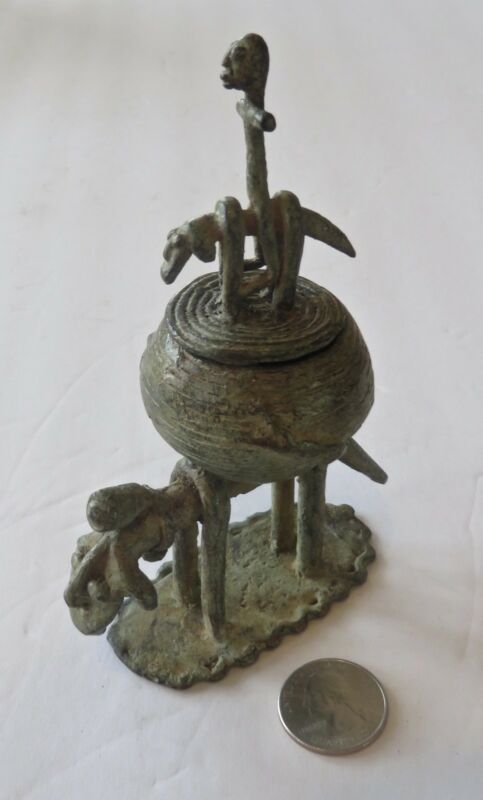-40%
Rare, Antique, Dogon, Cast Bronze Container, “Hogon” Equestrian Figure, Lid, 5"
$ 211.2
- Description
- Size Guide
Description
Rare, antique African cast bronze small container, bowl, 5" H, from the Dogon in Mali. Research shows that many important carved wooden images were also made in bronze, which would last much longer than the wooden works. Two important reference books I have on Dogon art show this same image in wood, and the book “Dogon Cliff Dwellers” by Pascal James Imperato, from a 1978 catalog at the Kahan gallery of African Art, has a small section on “Cups” with a with a very similar image, stating: “This sculpture is a type of bowl used by hogons. According to Dogon tradition cups of this type were often sculpted for a hogon at the time of his installation as a chief,priest and leader of a village or section of a village. Sometimes the cup or bowl used by his predecessor were transferred to him ceremonially at this time. From a functional point of view these cups often serve at storage places for a variety of things...They often depict the hogon seated on top of either a horse or a donkey. At a different level of interpretation the seated figure represent not merely a hog but rather the first hogan, i.e. Lebe, the first man who died and who introduced death to mankind”.
Bronze casting has a long history in Africa, going back to the 14th or 15th century, and culminating in the beautiful bronze wall plaques in Benin that record the images of the warriors that fought in the service of the Oba, King of Benin. I was told by an African friend that bronze pieces had various meanings for the individuals who owned them. They would have been taken into the “society house” (similar to a meeting place, church, shrine) and used for various rituals, but also placed in family shrines, and may also be used in funeral services and placed in burial graves.
This bowl has a “crusty" green brown patina to it, and as a sculptor I recognize it as a very old one, probably from the work being buried for some time - not one that might be made recently, so I believe this can easily be a pre-1900 work. Another sign of age is a rough treatment to one side of the bowl, where the “sprue” would have been placed for the metal to flow in. An interesting article I read about Dogon bronzes stated that until later colonial (French) times in Mali, the bronze caster did not have access to “files” for finer detailed finishing and would only use stones for finishing. (A very interesting fact I thought!). Also note the funny, what looks like a rope or a bell, or what? around the neck of the animal!
Watch for the other wonderful bronze works I bought and will list.
_gsrx_vers_836 (GS 7.0.14 (836))


















